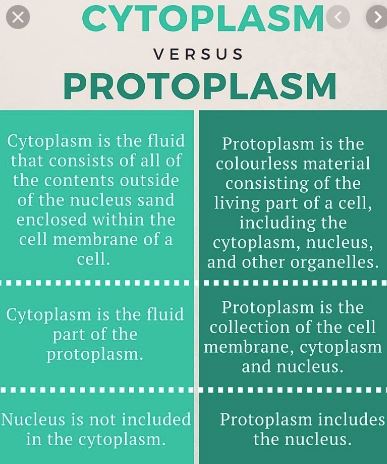What is Difference Between Cytoplasm And Protoplasm?
Difference Between Cytoplasm And Protoplasm is that The word protoplasm is derived from the Greek word “protos” which means “first” and “plasma,” which means “things formed.” The protoplasm is considered as the physical basis of life.
The protoplasm of a cell consists of a nucleus, cell membrane, and cytoplasm. Therefore, the cytoplasm is a part of a cell’s protoplasm.
The cytoplasm is not different from the protoplasm, but a part of it. They are cell suspensions and provide an environment in which biological processes take place.
The protoplasm is surrounded by a plasma membrane or cell membrane on all sides, while the cytoplasm is the substance that surrounds the nucleus within a cell.
COMPONENTS
The cytoplasm is composed of cytosol, organelles, and inclusions while the protoplasm is composed of the cytoplasm, the nucleus, and the cell membrane. The cytosol of the cytoplasm is composed of water, salts and organic molecules.
Organelles are tiny organs, such as structures, that are present in a cell and that have specific functions. Inclusions are insoluble particles present in the cytoplasm.
The protoplasm is considered as a living substance that is inside the cell. It is a complex substance, translucent, with a semi-fluid consistency and is mainly composed of nucleic acids, proteins, lipids, carbohydrates, and inorganic salts.
STRUCTURAL DIFFERENCE
the cytoplasm does not have a nucleus, while the protoplasm does have a nucleus in its structure.
The cytoplasm is an organelle of the protoplasm, which consists mainly of water and other substances such as proteins, food reserves, and metabolic wastes.
The protoplasm is a viscous substance with gelatinous consistency in which many biological and chemical cellular processes take place. In cells that have the presence of a nucleus, the protoplasm surrounding that nucleus is called cytoplasm.
All cell contents are in the cytoplasm in prokaryotic cells (organisms that lack a nucleus) while in eukaryotic cells the cellular contents present in the nucleus are differentiated from the cytoplasm by a defined nuclear membrane. The set of contents present in the nucleus is called nucleoplasm.
CHEMICAL PROPERTIES
The inorganic substances that constitute the protoplasm are mainly water, mineral salts, and gases.
FUNCTIONAL DIFFERENCES
The organelles present in the cytoplasm are the body of Golgi, mitochondria, endoplasmic reticulum and ribosomes. These organelles have different very specific functions. Mitochondria have the function of cellular respiration, while ribosomes act as laboratories that synthesize proteins.
Other important functions that occur in the cytoplasm are glycolysis and cell division processes. The protoplasm is also considered as a living part of the cell since all the important processes that are needed for the life of the cell are carried out in the protoplasm.
It is also said that the protoplasm shapes the body since it is a transparent, viscous and watery substance.
SUMMARY
The difference between the protoplasm and the cytoplasm is very thin. The protoplasm is the content of the cell, including the cell membrane, cytoplasm, and the nucleus, while the cytoplasm is the gelatinous substance that surrounds the nucleus within the cell membrane.
The cytoplasm contains cellular organelles such as mitochondria, ribosomes, etc. In prokaryotic cells, where there is no well-defined nucleus, the cytoplasm acts as a nucleoplasm and contains chromatin.
You May Also Interested:
